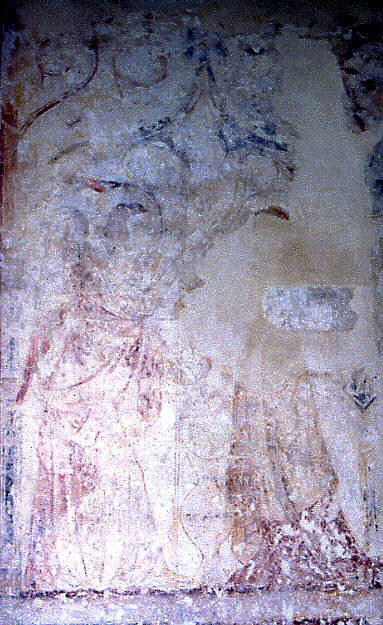Tarrant Crawford, Dorset (†Salisbury [Sarum]) C.14
The Annunciation

The faded remains of a very fine Annunciation. It is comparable for quality to the contemporary painting of the same subject at South Newington in Oxfordshire.
The winged figure of Gabriel is on the left, holding a tall narrow sceptre and with a speech-scroll which probably once bore the words of his Salutation. The Virgin is at the right, possibly also with a speech-scroll, but these details are very hard to see. In between the two at the bottom of the picture, and faintly outlined now, is a lily-pot with, at the right, a reversed-C shaped handle. There is perhaps a lectern or reading-desk at the far right, beyond the Virgin.
The draperies of the two well proportioned and articulated figures have an easy elegance. Most of the paintings at Tarrant Crawford are framed within painted tabernacles in architectural Decorated style, and the upper part of one shows at the top of the picture.
A second piscina (in addition to that serving the High Altar in the chancel) near the painting suggests that it was set above a Lady Altar, dedicated to the Virgin. Nave piscinas of this kind, marking the location of a Lady Chapel or altar, are still fairly commonly found.
Nearby Tarrant Abbey (formerly called Tarrant Kaines/Keynes) was once a wealthy house of (eventually) Cistercian nuns. Nothing is left of it apart from a medieval barn, and it is most unlikely that the nuns, who had various problems of their own to contend with during the 14th century¹, had any hand in commissioning the paintings in the church. In addition to the Annunciation, these include a damaged but very full Life of St Margaret (forthcoming) and a Three Living & Three Dead.
Website for St Mary the Virgin, Tarrant Crawford
¹They were strictly enclosed after 1303 following Pope Boniface VIII’s Bull Periculoso. And in 1343 their Abbess was granted a license to cut down (possibly for fuel, possibly to clear the land for rebuilding) 200 acres of underwood on their demesne because “their house and possessions in the county of Dorset had been burned and destroyed by an invasion of the king’s enemies in those parts”. [Eileen Power, Medieval English Nunneries, Cambridge, 1922, p.350, 434 ]